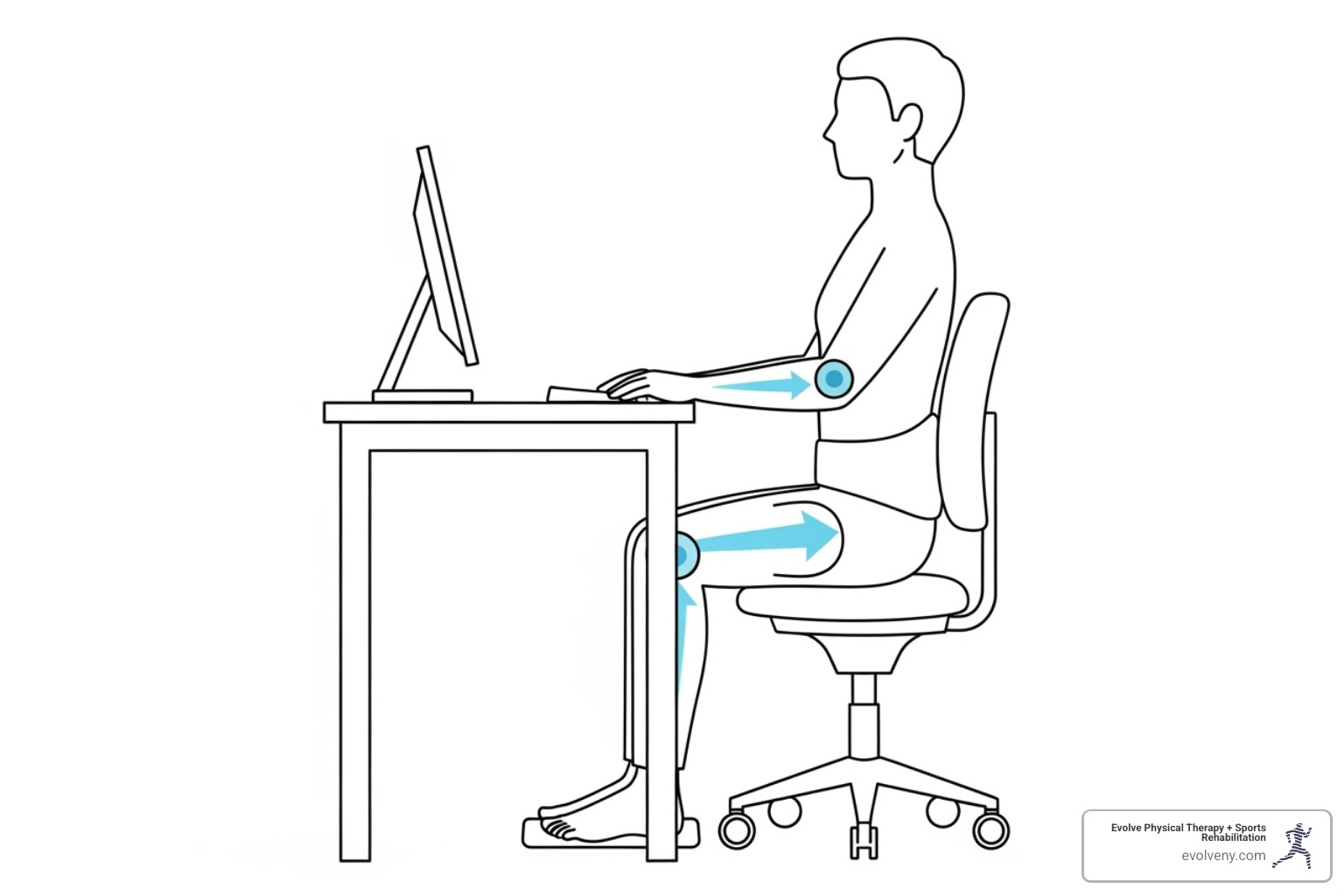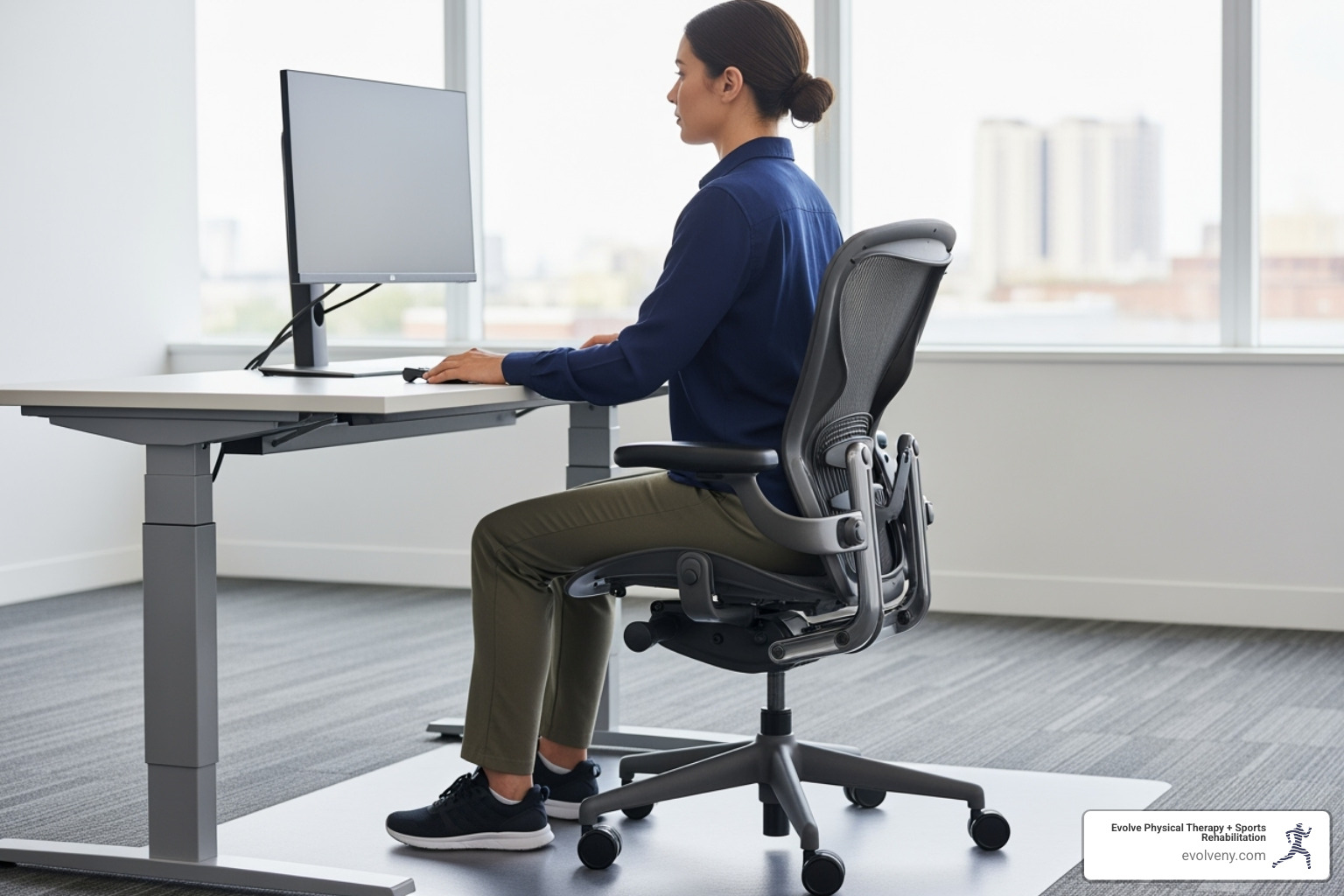Good Posture for Office Workers: Sit Up, Stand Out, Feel Great
Why Your Desk Job is Taking a Toll on Your Body

Good posture for office workers is about protecting your health from the silent dangers of prolonged sitting. With many people spending over half their workday seated, the risk for musculoskeletal problems is high.
Essential elements of good posture for office workers:
- Feet flat on the floor or footrest
- Knees at 90 degrees and level with hips
- Back supported with natural lumbar curve maintained
- Shoulders relaxed and arms at 90-degree angles
- Head aligned over spine, not jutting forward
- Monitor at eye level to prevent neck strain
Sitting all day increases your risk of diabetes and cardiovascular disease, while poor posture leads to back pain, neck strain, and headaches. Your body wasn't designed to be static for hours.
Fortunately, small adjustments to your posture and workstation can make a huge difference. The key is understanding that no single position is comfortable indefinitely; movement and proper ergonomics are your best defense.
I'm Lou Ezrick, founder of Evolve Physical Therapy. For nearly two decades, I've helped professionals overcome chronic pain. I've seen how implementing good posture for office workers strategies can transform comfort and quality of life.
The Hidden Dangers of Poor Posture and Prolonged Sitting
That stiff neck, aching back, or pain between your shoulder blades are warning signs that your desk job is taking a toll. Our bodies were designed to move, but we force them into static positions for hours, fighting against millions of years of evolution. The toll on our bodies is significant, creating a cascade of health problems.
The combination of prolonged sitting and poor posture creates a perfect storm for musculoskeletal disorders. Your spine loses its natural curves, muscles weaken, and your body adapts to these unnatural positions. These changes often happen so gradually that you don't notice them until the pain becomes constant.
The Physical Consequences of Slouching
Slouching puts unnecessary strain on spinal ligaments and muscles. Think of it like wearing a heavy backpack all day—eventually, something gives.
Back pain: Sitting puts 40% more pressure on your spine than standing. Poor posture adds to this, putting lumbar discs under constant siege. If you have chronic back pain, your workstation is a likely culprit.
Forward head posture: Your head weighs about 12 pounds, but when it juts forward, the strain on your neck muscles can triple. This leads to persistent neck pain and tension headaches.
Rounded shoulders: Constantly reaching for your keyboard and mouse internally rotates your shoulders and tightens chest muscles, creating a hunched appearance and causing pain and stiffness.
Digestive issues and poor circulation: Slouching compresses abdominal organs, slowing digestion. Sitting for long periods also reduces blood flow to your legs, leaving you feeling sluggish.
Serious health conditions: Extended sitting increases your risk of cardiovascular disease and diabetes, leading some researchers to call it "the new smoking." Nerve constriction from tight hip flexors can also lead to sciatica.
The Surprising Benefits of Sitting Up Straight
The benefits of maintaining good posture for office workers go beyond avoiding pain. Proper alignment improves your performance and well-being.
Increased energy: When your body is aligned, your muscles work more efficiently, leaving you feeling less drained at the end of the day.
Improved mood and confidence: Research shows that an upright, open posture can boost your mood. When you sit up straight, you embody confidence and alertness.
Better concentration: Without the distraction of aches and pains, your brain can focus on the task at hand. Many patients report improved work performance after addressing posture.
Injury prevention: Proper alignment distributes weight evenly, reducing stress on joints and soft tissues. It's much easier to maintain good posture than to recover from chronic pain.
Improved productivity and sleep: When you feel better, have more energy, and can concentrate, your work quality improves. Addressing physical discomfort also leads to better sleep, as your body can finally relax and recover.
Implementing good posture for office workers is an investment in your long-term health, comfort, and performance. Small changes can yield big results.
The Blueprint for Perfect Desk Posture
Good posture for office workers is about finding a comfortable, natural position where your body feels supported and aligned. It's not about sitting rigidly, but about understanding the principles of neutral body positioning and making smart adjustments for your specific needs.

Achieving the "Neutral" Position: A Step-by-Step Guide
Neutral body positioning is your body's natural resting state, where joints are aligned and muscles aren't overworked. It's the foundation of good posture for office workers.
- Feet: Rest flat on the floor or a footrest to create a stable foundation.
- Knees and Hips: Keep knees and hips at roughly 90-degree angles, with knees at or slightly below hip level.
- Pelvis: Sit all the way back in your chair so your buttocks touch the backrest. Your pelvis should be neutral, not tilted forward or backward.
- Lower Back: Support your lower back's natural curve with your chair's lumbar support or a small pillow.
- Shoulders and Arms: Let your shoulders relax and drop. Your upper arms should hang at your sides with elbows bent between 90 and 120 degrees.
- Wrists: Keep wrists straight and in line with your forearms, floating over the keyboard rather than resting heavily.
- Head: Align your head over your spine, with your ears directly over your shoulders. Practice a gentle "chin tuck."
- Monitor: Position your monitor at eye level, about an arm's length away. The top of the screen should be at or slightly below eye level.
The Mayo Clinic's office ergonomics guide offers more detail on achieving ideal computer posture.
Common Mistakes to Avoid When Trying for Good Posture for Office Workers
Even with good intentions, it's easy to sabotage your posture. Here are common mistakes to avoid:
- The "military straight" mistake: Over-arching your lower back creates as much strain as slouching. Good posture should feel comfortable, not rigid.
- Drifting away from your backrest: You gradually lean forward, abandoning your chair's support and forcing your back muscles to work overtime.
- Crossing your legs or dangling feet: This throws off your alignment and can cause circulation problems.
- Phone cradling: Cradling a phone between your shoulder and ear is a recipe for neck pain. Use a headset or speakerphone.
- Reaching for items: Keep your mouse, phone, and other essentials within easy reach to avoid constant stretching and twisting.
- Ignoring your body's signals: Pain, stiffness, or tingling are signs that something needs to change. Address discomfort before it becomes a bigger problem.
These patterns often develop gradually, which is why many people with bad office posture don't realize their habits have shifted.
Ergonomics 101: Setting Up Your Workstation for Success
Your workstation is the foundation of your posture. If your chair is too low or your monitor is positioned wrong, you'll find yourself slouching. Ergonomics is the science of designing your workspace to fit your body, not the other way around.
Good posture for office workers is easier to maintain when your environment makes proper alignment feel natural. A well-designed workstation allows you to work in a neutral posture, with your spine aligned and everything adjusted to your body. The HSE's guidance on working safely with display screen equipment emphasizes that good ergonomics prevents problems before they start.
Your Chair, Desk, and Monitor: The Core Trio
These three pieces must work together. Here's how to set them up for optimal support.

Chair: Adjust the seat height so your feet are flat on the floor and thighs are parallel to the ground. For seat depth, leave two to four fingers of space between the back of your knees and the seat edge. Lumbar support is non-negotiable for maintaining correct computer posture; it should cradle the inward curve of your lower back. Adjust armrests to support your forearms, keeping shoulders relaxed.
Desk: Your keyboard should be at elbow height, allowing your arms to hang naturally with elbows at about 90 degrees. If your desk is too high, raise your chair and use a footrest.
Monitor: Position your screen directly in front of you, an arm's length away. The top of the screen should be at or slightly below eye level to keep your neck neutral. If you wear bifocals, you may need to lower it slightly.
Essential Ergonomic Accessories (and DIY Alternatives)
Sometimes, accessories are needed to achieve good posture for office workers. You don't need to break the bank.
- Footrest: Essential if your feet don't touch the floor when your chair is at the right height. A stack of sturdy books or a small stool can work as a DIY alternative.
- Lumbar Support: A dedicated pillow can help if your chair's support is inadequate. A rolled-up towel is a surprisingly effective and free alternative.
- For Laptop Users: Laptops create an ergonomic nightmare. Use an external keyboard and mouse, and raise your laptop screen to eye level with a monitor stand (or a stack of books).
- Headset: A must-have if you're on the phone frequently. It prevents the neck-damaging habit of cradling the phone.
Our Ergonomic Physical Therapy team can provide personalized recommendations to optimize your setup.
Movement is Medicine: Stretches and Habits for Good Posture for Office Workers
Even with a perfect setup, staying glued to your chair for hours will harm your body. The human body wasn't designed to be static. The CSA Standard recommends alternating between sitting and standing because prolonged static positions are harmful, regardless of posture.
Movement is medicine. Small, frequent movements throughout your workday can dramatically improve how you feel and help maintain that good posture for office workers.
Simple Desk Stretches to Relieve Tension
These simple stretches can be done at your workstation to target areas that suffer from prolonged sitting.

- Neck stretches: Gently tilt your ear toward your shoulder, holding for 5-10 seconds on each side. Slowly turn your head to look over each shoulder to counteract forward head posture.
- Shoulder rolls and shrugs: Roll your shoulders forward and backward in slow circles. Shrug your shoulders up toward your ears, hold, then release to relieve tension.
- Chest opener: Clasp your hands behind your back and gently squeeze your shoulder blades together to counteract a hunched posture.
- Torso twists: While seated, gently rotate your torso to each side, using your chair for support, to keep your spine mobile.
- Wrist stretches: Extend one arm and gently pull your fingers toward your body, first with the palm down, then with the palm up. This helps prevent repetitive strain injuries.
Regular stretching can reduce your risk of developing upper back pain and other office-related issues.
Building a Routine: The Importance of Regular Breaks
Taking regular movement breaks is the single most transformative habit for your workday health. The research is clear: sitting for hours is damaging.
Aim to take a one to two-minute break every 30 minutes, or at least get up and move every hour. You can use the Pomodoro Technique (25 minutes of work, 5-minute break) or the 20-20-20 rule for eye health (every 20 minutes, look at something 20 feet away for 20 seconds).
During these breaks, stand and walk to improve blood flow and reduce muscle fatigue. Try to perform some tasks while standing, like taking phone calls. The people who feel best at the end of the day are those who move regularly.
Building this routine takes conscious effort at first, so set reminders if needed. The OSHA guidelines emphasize varying your working positions. Movement isn't just nice to have—it's essential medicine for maintaining good posture for office workers.
Frequently Asked Questions about Good Posture for Office Workers
As a physical therapist serving Brooklyn communities like Marine Park, Gravesend, and Park Slope, I hear the same questions about good posture for office workers.
How long does it take to correct bad posture?
There's no magic timeline. Correcting bad posture is a gradual process of retraining your muscles and building new movement patterns. Most people feel improvements within a few weeks of consistent effort, but significant, lasting changes can take several months. The key is consistency; you didn't develop poor posture overnight, so be patient with yourself.
Can a standing desk solve all my posture problems?
Standing desks are a valuable tool, but not a miracle cure. They help reduce sedentary time, but good standing posture is still required. Many people simply trade poor sitting posture for poor standing posture. The real benefit comes from alternating between sitting and standing throughout the day. This variation prevents your body from getting stuck in one position for too long.
What if I still have pain after improving my posture and ergonomics?
This is a crucial question. If you've improved your posture and ergonomics but still have persistent pain, it's a clear sign that professional evaluation is needed. Persistent pain often indicates underlying issues like muscle imbalances, joint dysfunction, or nerve irritation that require targeted treatment.
Don't ignore ongoing pain. At Evolve Physical Therapy + Sports Rehabilitation, we offer comprehensive evaluations to identify the root cause of your pain. Our physical therapists develop personalized treatment plans that may include specialized exercises, manual therapy, and customized ergonomic recommendations. Professional consultation is crucial when self-correction isn't enough.
Conclusion: Make Good Posture Your New Normal
Achieving good posture for office workers is a daily investment in your future self, one that pays dividends in energy, comfort, and well-being. We've seen how a desk job can contribute to chronic pain and increase health risks, but also how proper posture can boost energy, mood, and concentration.
The blueprint is simple: aim for 90-degree angles, ensure proper lumbar support, and keep your monitor at eye level. Small adjustments, whether with ergonomic accessories or DIY solutions, create meaningful change.
Most importantly, movement is medicine. Your body wasn't designed to be static. Regular stretches and brief walks are non-negotiable for your long-term health. Making good posture for office workers your new normal requires consistency and patience. The goal is awareness and making small corrections throughout your day.
If you're struggling to implement these changes or if pain persists, you don't have to go it alone. Our team at Evolve Physical Therapy + Sports Rehabilitation specializes in helping professionals overcome the physical challenges of desk work. We provide personalized, hands-on care to the Brooklyn communities of Marine Park, Gravesend, Midwood, Park Slope, and Mill Basin.
Your health is worth the investment. Take charge of your posture and find what it feels like to work comfortably and confidently. Learn more about our Ergonomic Physical Therapy services in Brooklyn and let us help you evolve your well-being.

